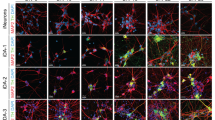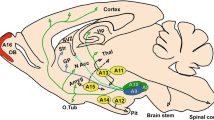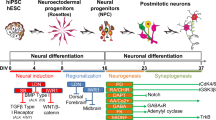Abstract
The role of dopamine D2 and D3 receptors (D2R/D3R), located on midbrain dopaminergic (DA) neurons, in the regulation of DA synthesis and release and in DA neuron homeostasis has been extensively investigated in rodent animal models. By contrast, the properties of D2R/D3R in human DA neurons have not been elucidated yet. On this line, the use of human-induced pluripotent stem cells (hiPSCs) for producing any types of cells has offered the innovative opportunity for investigating the human neuronal phenotypes at the molecular levels. In the present study, hiPSCs generated from human dermal fibroblasts were used to produce midbrain DA (mDA) neurons, expressing the proper set of genes and proteins typical of authentic, terminally differentiated DA neurons. In this model, the expression and the functional properties of the human D2R/D3R were investigated with a combination of biochemical and functional techniques. We observed that in hiPSC-derived mDA neurons, the activation of D2R/D3R promotes the proliferation of neuronal progenitor cells. In addition, we found that D2R/D3R activation inhibits nicotine-stimulated DA release and exerts neurotrophic effects on mDA neurons that likely occur via the activation of PI3K-dependent mechanisms. Furthermore, D2R/D3R stimulation counteracts both the aggregation of alpha-synuclein induced by glucose deprivation and the associated neuronal damage affecting both the soma and the dendrites of mDA neurons. Taken together, these data point to the D2R/D3R-related signaling events as a biochemical pathway crucial for supporting both neuronal development and survival and protection of human DA neurons.






Similar content being viewed by others
References
Diaz J, Pilon C, Le Foll B, Gros C, Triller A, Schwartz JC, Sokoloff P (2000) Dopamine D3 receptors expressed by all mesencephalic dopamine neurons. J Neurosci 20:8677–8684
De Mei C, Ramos M, Iitaka C, Borrelli E (2009) Getting specialized: presynaptic and postsynaptic dopamine D2 receptors. Curr Opin Pharmacol 9(1):53–58. doi:10.1016/j.coph.2008.12.002
Sokoloff P, Diaz J, Le Foll B, Guillin O, Leriche L, Bezard E, Gross C (2006) The dopamine D3 receptor: a therapeutic target for the treatment of neuropsychiatric disorders. CNS Neurol Disord Drug Targets 5:25–43
Le Foll B, Diaz J, Sokoloff P (2005) Neuroadaptations to hyperdopaminergia in dopamine D3 receptor-deficient mice. Life Sci 76(11):1281–1296
Maina FK, Mathews TA (2010) A functional fast scan cyclic voltammetry assay to characterize dopamine D2 and D3 autoreceptors in the mouse striatum. ACS Chem Neurosci 1(6):450–462
Missale C, Nash SR, Robinson SW, Jaber M, Caron MG (1998) Dopamine receptors: from structure to function. Physiol Rev 78(1):189–225
Beaulieu JM, Gainetdinov RR (2011) The physiology, signaling, and pharmacology of dopamine receptors. Pharmacol Rev 63(1):182–217. doi:10.1124/pr.110.002642
Fiorentini C, Savoia P, Bono F, Tallarico P, Missale C (2015) The D3 dopamine receptor: from structural interactions to function. Eur Neuropsychopharmacol 25(9):1462–1469. doi:10.1016/j.euroneuro.2014.11.021
Todd RD (1992) Neural development is regulated by classical neurotransmitters: dopamine D2 receptor stimulation enhances neurite outgrowth. Biol Psychiatry 31(8):794–807
Spencer GE, Klumperman J, Syed NI (1998) Neurotransmitters and neurodevelopment. Role of dopamine in neurite outgrowth, target selection and specific synapse formation. Perspect Dev Neurobiol 5(4):451–467
Belinsky GS, Sirois CL, Rich MT, Short SM, Moore AR, Gilbert SE, Antic SD (2013) Dopamine receptors in human embryonic stem cell neurodifferentiation. Stem Cells Dev 22(10):1522–1540. doi:10.1089/scd.2012.0150
Van Kampen JM, Robertson HA (2005) A possible role for dopamine D3 receptor stimulation in the induction of neurogenesis in the adult rat substantia nigra. Neuroscience 136:381–386
O’Keeffe GC, Tyers P, Aarsland D, Dalley JW, Barker RA, Caldwell MA (2009) Dopamine-induced proliferation of adult neural precursor cells in the mammalian subventricular zone is mediated through EGF. Proc Natl Acad Sci U S A 106(21):8754–8759. doi:10.1073/pnas.0803955106
Kim Y, Wang WZ, Comte I, Pastrana E, Tran PB, Brown J, Miller RJ, Doetsch F et al (2010) Dopamine stimulation of postnatal murine subventricular zone neurogenesis via the D3 receptor. J Neurochem 114(3):750–760. doi:10.1111/j.1471-4159.2010.06799.x
Collo G, Bono F, Cavalleri L, Plebani L, Merlo Pich E, Millan MJ, Spano PF, Missale C (2012) Pre-synaptic dopamine D(3) receptor mediates cocaine-induced structural plasticity in mesencephalic dopaminergic neurons via ERK and Akt pathways. J Neurochem 120:765–778
Collo G, Zanetti S, Missale C, Spano PF (2008) Dopamine D3 receptor-preferring agonists increase dendrite arborization of mesencephalic dopaminergic neurons via extracellular signal-regulated kinase phosphorylation. Eur J Neurosci 28:1231–1240
Kim SY, Choi KC, Chang MS, Kim MH, Kim SY, Na YS, Lee JE, Jin BK et al (2006) The dopamine D2 receptor regulates the development of dopaminergic neurons via extracellular signal-regulated kinase and Nurr1 activation. J Neurosci 26(17):4567–4576
Yoon S, Choi MH, Chang MS, Baik JH (2011) Wnt5a-dopamine D2 receptor interactions regulate dopamine neuron development via extracellular signal-regulated kinase (ERK) activation. Biol Chem 286(18):15641–15651
Whone AL, Watt RL, Stoessl AJ, Davis M, Reske S, Nahmias C, Lang AE, Rascol O et al (2003) Slower progression of Parkinson’s disease with ropinerole versus levodopa: the REAL-PET study. Ann Neurol 54:93–101
Van Kampen JM, Eckman CB (2006) Dopamine D3 receptor agonist delivery to a model of Parkinson’s disease restores the nigrostriatal pathway and improves locomotor behavior. J Neurosci 26:7272–7280
Bellucci A, Collo G, Sarnico I, Battistin L, Missale C, Spano P (2008) Alpha-synuclein aggregation and cell death triggered by energy deprivation and dopamine overload are counteracted by D2/D3 receptor activation. J Neurochem 106(2):560–577. doi:10.1111/j.1471-4159.2008.05406.x
Benskey MJ, Perez RG, Manfredsson FP (2016) The contribution of alpha synuclein to neuronal survival and function - implications for Parkinson’s disease. J Neurochem 37(3):331–359. doi:10.1111/jnc.13570
Takahashi K, Tanabe K, Ohnuki M, Narita M, Ichisaka T, Tomoda K, Yamanaka S (2007) Induction of pluripotent stem cells from adult human fibroblasts by defined factors. Cell 131:861–872
Yu J, Vodyanik MA, Smuga-Otto K, Antosiewicz-Bourget J, Frane JL, Tian S, Nie J, Jonsdottir GA et al (2007) Induced pluripotent stem cell lines derived from human somatic cells. Science 318(5858):1917–1920
Chambers SM, Fasano CA, Papapetrou EP, Tomishima M, Sadelain M, Studer L (2009) Highly efficient neural conversion of human ES and iPS cells by dual inhibition of SMAD signaling. Nat Biotechnol 27(3):275–280. doi:10.1038/nbt.1529
Kriks S, Shim JW, Piao J, Ganat YM, Wakeman DR, Xie Z, Carrillo-Reid L, Auyeung G et al (2011) Dopamine neurons derived from human ES cells efficiently engraft in animal models of Parkinson’s disease. Nature 480(7378):547–551
Hartfield EM, Yamasaki-Mann M, Ribeiro Fernandes HJ, Vowles J, James WS, Cowley SA, Wade-Martins R (2014) Physiological characterisation of human iPS-derived dopaminergic neurons. PLoS One 9(2):e87388. doi:10.1371/journal.pone.0087388
Zaltieri M, Grigoletto J, Longhena F, Navarria L, Favero G, Castrezzati S, Colivicchi MA, Della Corte L et al (2015) α-synuclein and synapsin III cooperatively regulate synaptic function in dopamine neurons. J Cell Sci 128:2231–2243
Schmidt U, Beyer C, Oestreicher AB, Rejsert I, Schilling K, Pilgrim C (1996) Activation of dopaminergic D1 receptors promotes morphogenesis of developing striatal neurons. Neurosci 74:453–460
Maherali N, Ahfeldt T, Rigamonti A, Utikal J, Cowan C, Hochedlinger K (2008) A high-efficiency system for the generation and study of human induced pluripotent stem cells. Cell Stem Cell 3(3):340–345
Tucker RP (1990) The roles of microtubule-associated proteins in brain morphogenesis: a review. Brain Res Brain Res Rev 15(2):101–120
Picciotto MR, Zoli M, Rimondini R, Léna C, Marubio LM, Pich EM, Fuxe K, Changeux JP (1998) Acetylcholine receptors containing the beta2 subunit are involved in the reinforcing properties of nicotine. Nature 391:173–177
Changeux JP (2010) Nicotine addiction and nicotinic receptors: lessons from genetically modified mice. Nat Rev Neurosci 11:389–401
Chen P-C, Lao C-L, Chen J-C (2009) The D3 dopamine receptor inhibits dopamine release in PC-12/hD3 cells by autoreceptor signaling via PP-2B, CK1, and Cdk-5. J Neurochem 110(4):1180–1190. doi:10.1111/j.1471-4159.2009.06209
Collo G, Bono F, Cavalleri L, Plebani L, Mitola S, Merlo Pich E, Millan MJ, Zoli M et al (2013) Nicotine-induced structural plasticity in mesencephalic dopaminergic neurons is mediated by dopamine D3 receptors and Akt-mTORC1 signaling. Mol Pharmacol 83(6):1176–1189
Reith ME, Coffey LL, Xu C, Chen N-H (1994) GBR 12909 and 12935 block dopamine uptake into brain synaptic vesicles as well as nerve endings. Eur J Pharmacol 253(1–2):175–178
Swarzenski BC, Tang L, Oh YJ, O’Malley KL, Todd RD (1994) Morphogenic potentials of D2, D3, and D4 dopamine receptors revealed in transfected neuronal cell lines. Proc Natl Acad Sci U S A 91(2):649–653
Höglinger GU, Rizk P, Muriel MP, Duyckaerts C, Oertel WH, Caille I, Hirsch EC (2004) Dopamine depletion impairs precursor cell proliferation in Parkinson disease. Nat Neurosci 7(7):726–735
Baker SA, Baker KA, Hagg T (2004) Dopaminergic nigrostriatal projections regulate neural precursor proliferation in the adult mouse subventricular zone. Eur J Neurosci 20(2):575–579
Reinhardt P, Schmid B, Burbulla LF, Schöndorf DC, Wagner L, Glatza M, Höing S, Hargus G et al (2013) Genetic correction of a LRRK2 mutation in human iPSCs links parkinsonian neurodegeneration to ERK-dependent changes in gene expression. Cell Stem Cell 12(3):354–367. doi:10.1016/j.stem.2013.01.008
Alonso M, Medina JH, Pozzo-Miller L (2004) ERK1/2 activation is necessary for BDNF to increase dendritic spine density in hippocampal CA1 pyramidal neurons. Learn Mem 11:172–178
Kumar V, Zhang M-X, Swank MW, Kunz J, Wu G-Y (2005) Regulation of dendritic morphogenesis by Ras-PI3K-Akt-mTOR and Ras-MAPK signaling pathways. J Neurosci 25:11288–11299
Thomas GM, Huganir RL (2004) MAPK cascade signalling and synaptic plasticity. Nat Rev Neurosci 5:173–183
Rivera A, Trías S, Peñafiel A, Angel Narváez J, Díaz-Cabiale Z, Moratalla R, de la Calle A (2003) Expression of D4 dopamine receptors in striatonigral and striatopallidal neurons in the rat striatum. Brain Res 989:35–41
Rondou P, Haegeman G, Van Craenenbroeck K (2010) The dopamine D4 receptor: biochemical and signalling properties. Cell Mol Life Sci 67:1971–1986
Khan ZU, Gutiérrez A, Martín R, Peñafiel A, Rivera A, De La Calle A (1998) Differential regional and cellular distribution of dopamine D2-like receptors: an immunocytochemical study of subtype-specific antibodies in rat and human brain. J Comp Neurol 402:353–371
Fiorentini C, Gardoni F, Spano P, Di Luca M, Missale C (2003) Regulation of dopamine D1 receptor trafficking and desensitization by oligomerization with glutamate N-methyl-D-aspartate receptors. J Biol Chem 278:20196–20202
Liu F, Wan Q, Pristupa ZB, Yu XM, Wang YT, Niznik HB (2000) Direct protein-protein coupling enables cross-talk between dopamine D5 and gamma-aminobutyric acid a receptors. Nature 403:274–280
Quarta D, Ciruela F, Patkar K, Borycz J, Solinas M, Lluis C, Franco R, Wise RA et al (2007) Heteromeric nicotinic acetylcholine-dopamine autoreceptor complexes modulate striatal dopamine release. Neuropsychopharmacology 32:35–42
Lüscher C, Malenka RC (2011) Drug-evoked synaptic plasticity in addiction: from molecular changes to circuit remodeling. Neuron 69(4):650–663. doi:10.1016/j.neuron.2011.01.017
Olive MF, Gass JT (2015) Editorial: structural plasticity induced by drugs of abuse. Front Pharmacol 6:88. doi:10.3389/fphar.2015.00088
Benowitz NL (2010) Nicotine addiction. N Engl J Med 362(24):2295–2303. doi:10.1056/NEJMra0809890
Weiss HD, Marsh L (2012) Impulse control disorders and compulsive behaviors associated with dopaminergic therapies in Parkinson disease. Neurol Clin Pract 2(4):267–274
Holden C (2001) ’Behavioral’ addictions: do they exist? Science 294(5544):980–982
Xilouri M, Brekk OR, Stefanis L (2013) α-synuclein and protein degradation systems: a reciprocal relationship. Mol Neurobiol 47(2):537–551. doi:10.1007/s12035-012-8341-2
Shannon KM, Bennett JP Jr, Friedman JH (1997) Efficacy of pramipexole, a novel dopamine agonist, as monotherapy in mild to moderate Parkinson’s disease. The pramipexole study group. Neurology 49(3):724–728
Li C, Biswas S, Li X, Dutta AK, Le W (2010) Novel D3 dopamine receptor-preferring agonist D-264: evidence of neuroprotective property in Parkinson’s disease animal models induced by 1-methyl-4-phenyl-1,2,3,6-tetrahydropyridine and lactacystin. J Neurosci Res 88(11):2513–2523. doi:10.1002/jnr.22405
Barreto GE, Iarkov A, Moran VE (2015) Beneficial effects of nicotine, cotinine and its metabolites as potential agents for Parkinson’s disease. Front Aging Neurosci 6:340. doi:10.3389/fnagi.2014.00340
Ono K, Hirohata M, Yamada M (2007) Anti-fibrillogenic and fibril-destabilizing activity of nicotine in vitro: implications for the prevention and therapeutics of Lewy body diseases. Exp Neurol 205(2):414–424
Hong DP, Fink AL, Uversky VN (2009) Smoking and Parkinson’s disease: does nicotine affect alpha-synuclein fibrillation? Biochim Biophys Acta 1794(2):282–290. doi:10.1016/j.bbapap.2008.09.026
Kalia LV, Lang AE (2015) Parkinson’s disease. Lancet 386(9996):896–912. doi:10.1016/S0140-6736(14)61393-3
Caughey B, Lansbury PT (2003) Protofibrils, pores, fibrils, and neurodegeneration: separating the responsible protein aggregates from the innocent bystanders. Annu Rev Neurosci 26:267–298
Uversky VN, Eliezer D (2009) Biophysics of Parkinson’s disease: structure and aggregation of alpha-synuclein. Curr Protein Pept Sci 10(5):483–499
Acknowledgements
We thank Ginetta Collo and Laura Cavalleri for their contribution in hiPSC generation, and Lee L. Rubin and Eunju Chung for helping in the development of midbrain DA neurons differentiation. We are also grateful to Konrad Hochedlinger for plasmids located in the Addgene depository.
Author information
Authors and Affiliations
Corresponding author
Ethics declarations
Funding
This work was supported by “C. Golgi” Foundation, Brescia, Italy.
Conflict of Interest
The authors declare that they have no conflict of interest.
Ethics Approval
Informed consent was obtained from a healthy donor prior to cell donation. The local ethics committee (CEIOC—Fatebenefratelli Hospital “San Giovanni di Dio” – Brescia, Italy, 44/2001 and 39/2005), previously approved this consent form.
Electronic supplementary material
ESM 1
(DOCX 428 kb)
Rights and permissions
About this article
Cite this article
Bono, F., Savoia, P., Guglielmi, A. et al. Role of Dopamine D2/D3 Receptors in Development, Plasticity, and Neuroprotection in Human iPSC-Derived Midbrain Dopaminergic Neurons. Mol Neurobiol 55, 1054–1067 (2018). https://doi.org/10.1007/s12035-016-0376-3
Received:
Accepted:
Published:
Issue Date:
DOI: https://doi.org/10.1007/s12035-016-0376-3




